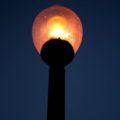A first-of-its-kind study by the University of Chicago Crime Lab New York (CLNY) found that increased street lighting can drive a significant reduction in criminal complaints.
Partnering with New York City Housing Authority (NYCHA) and the New York Police Department (NYPD), the study “sought to estimate the impact and cost-effectiveness of temporary street lights on crime and other measures of community well-being.”
The study targeted New York city housing developments with the highest levels of crime. Additional temporary street lighting was installed in a sample group of 39 developments, and another 38 were used as a control group.1 The sample group received on average 10 additional light towers, which remained illuminated at night-time throughout the six month study. The distribution of the extra lighting was randomised, to allow the researchers to determine, among other things, whether different amounts of lighting leads to different results.
Conclusive results
The study showed that the lighting had a significant effect. Crimes were divided into several categories, and in almost every case, levels fell in the housing developments with the additional lighting:
- Index crimes2 fell by 39% at night-time and 7% overall
- Felony crimes fell by 30% at night and 5% overall
- Assault, homicide and weapon crimes fell by 12% at night and 2% overall
Street lighting as a preventative for crime has been a subject of many studies, but none as detailed or conclusive as this one. There is a direct link, it concludes, between levels of street lighting and the number of crimes committed in a particular area. It provides a benchmark for authorities around the world to consider how they can improve the safety and security of citizens by optimising public lighting.
The study goes on to estimate the cost savings that these reduced levels of crime could provide. It says that the cost of installing additional permanent lighting would be paid for in six years. Over twenty years, the study says, the additional lighting will “reduce victimisation by approximately $14 million per development.” Even with a 4% reduction in this number to account for decreasing effectiveness, the savings over the same period would be around $10 million.
Balancing safety and sustainability
These results throw up an interesting conflict with another recent study which concluded that LED lighting is contributing to greater levels of light pollution than ever before. Considering that on average, each of the housing developments in CLNY’s study received an additional 6 million lumens worth of lighting, applying the same principle to every one of NYCHA’s 326 developments would total an additional 2 billion lumens of street lighting, equivalent to 4 million standard household light bulbs!
It is unlikely that such measures would be rolled out across the whole of the NYCHA estate, but it is perhaps cause to consider the effect such installations have beyond their immediate purposes. Balancing short-term results with long-term sustainability is an increasingly complex subject, but ensuring the safety of city residents at the cost of some additional light pollution might well seem worth it.
As LED technology continues to become more affordable and more scalable, such questions will become more common. After all, as a famous New York city crime-fighter knows, “with great power comes great responsibility.”
1. These housing developments received no additional lighting, so could be used to benchmark the effects of the group that did↩
2. “Index crime complaints include murder and non-negligent manslaughter, negligent or unclassified homicide, robbery, felony assault, burglary, grand larceny, and grand larceny of a motor vehicle.”↩




